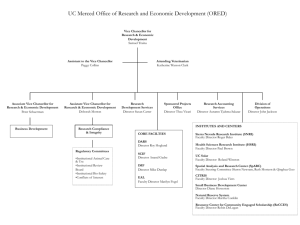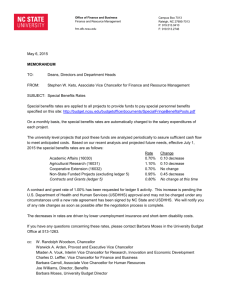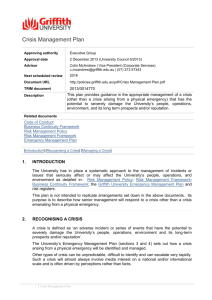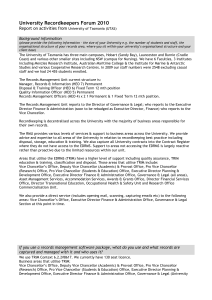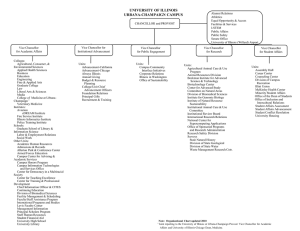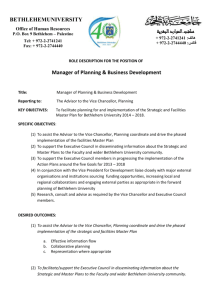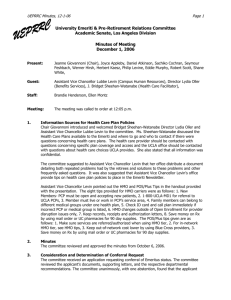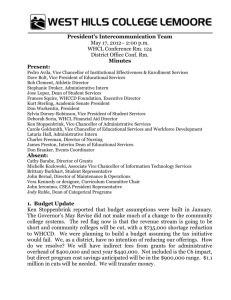How to use the assessment matrix
advertisement
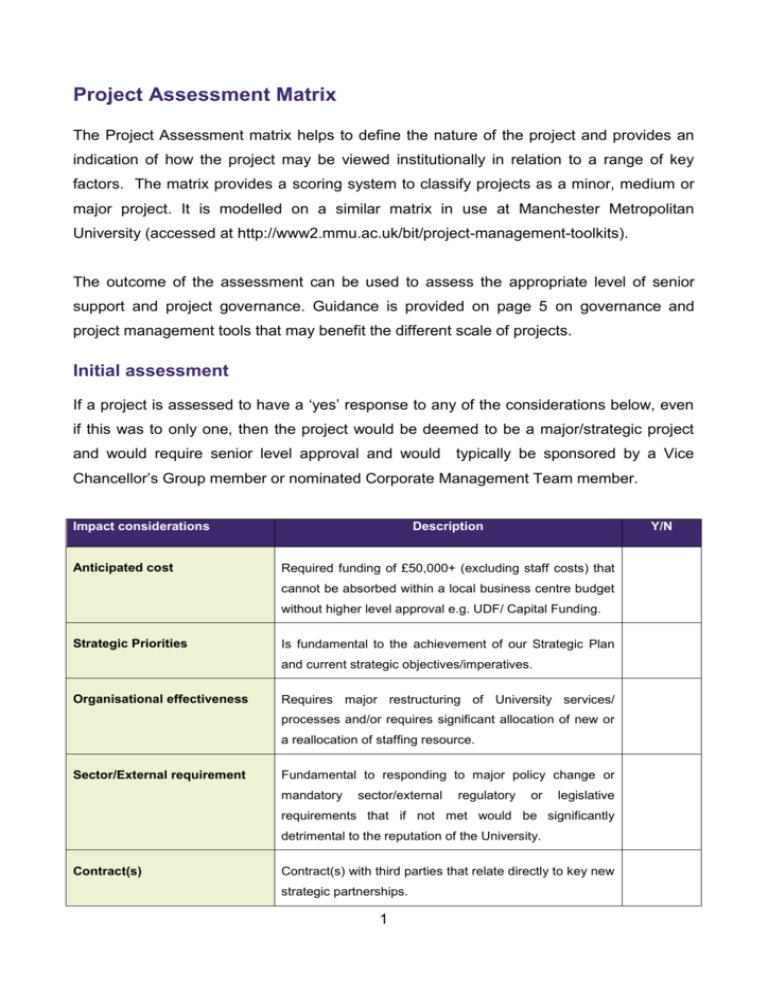
Project Assessment Matrix The Project Assessment matrix helps to define the nature of the project and provides an indication of how the project may be viewed institutionally in relation to a range of key factors. The matrix provides a scoring system to classify projects as a minor, medium or major project. It is modelled on a similar matrix in use at Manchester Metropolitan University (accessed at http://www2.mmu.ac.uk/bit/project-management-toolkits). The outcome of the assessment can be used to assess the appropriate level of senior support and project governance. Guidance is provided on page 5 on governance and project management tools that may benefit the different scale of projects. Initial assessment If a project is assessed to have a ‘yes’ response to any of the considerations below, even if this was to only one, then the project would be deemed to be a major/strategic project and would require senior level approval and would typically be sponsored by a Vice Chancellor’s Group member or nominated Corporate Management Team member. Impact considerations Anticipated cost Description Y/N Required funding of £50,000+ (excluding staff costs) that cannot be absorbed within a local business centre budget without higher level approval e.g. UDF/ Capital Funding. Strategic Priorities Is fundamental to the achievement of our Strategic Plan and current strategic objectives/imperatives. Organisational effectiveness Requires major restructuring of University services/ processes and/or requires significant allocation of new or a reallocation of staffing resource. Sector/External requirement Fundamental to responding to major policy change or mandatory sector/external regulatory or legislative requirements that if not met would be significantly detrimental to the reputation of the University. Contract(s) Contract(s) with third parties that relate directly to key new strategic partnerships. 1 How to use the assessment matrix There are two tables, one for impact and one for risk. Each table has ten considerations. - For each consideration, a score needs to be assigned o You should score each consideration from 0-4 o Score each consideration by highlighting the one most relevant to you. After completing this for each row, a table will have an overall score between 0 – 40. o The two scores can be used on the assessment grid on page 4 to determine the project type (not a project, minor, medium, major). Where a project is very close to an upper boundary on the matrix, it might be worth considering it as a project within the next level for added scrutiny. Each project type is described on more detail on page 5 of this document. 2 Impact Considerations Anticipated Cost 1 Timescale (months) Strategic priorities Score 0 Score 1 Score 2 Score 3 Score 4 No cost other than staff costs Allocated within the business centre budget Requires a redistribution of business centre budget Requires an increase to business centre budget Requires additional funds with senior level approval e.g. Capital Funding Less than 1 month 1-6 6 – 12 12 – 18 >18 Very minimal link Contributing to other work that is linked to a University supporting Strategy Contributing to other work that is linked to a strategic objective Key to the delivery of a University supporting Strategy Some new business processes and possibly some reallocation of or new staffing resource Significant restructure of processes and reallocation of or new staffing resource No link Impact on organisational effectiveness (structures/ processes/ resources) No impact Very minimal Some new business processes and possibly some re-training Sector/External, requirement No link to external imperative Very minimal links Some links to other work that is responding to a sector/external requirement Is a mandatory requirement that is to be implemented in one business area Is a mandatory requirement that impacts upon the work of more than one business area Stakeholders Minimal Internal and within single business area Internal across more than one business area Significant university-wide engagement Significant internal and external engagement Contract(s) No contract at all No new contracts required New contract required (no tender process) New contract required (tender process) Multiple new contacts required Track record Do this regularly Have done this before many times Have done this before once or twice Have done similar before Have not done anything like this before No dependency Very minimal links with other projects Links with other projects but little impact Links with other projects upon which this project depends Other projects depend upon this project No impact on students Very minimal impact on students Minor impact on student administration Minor impact on academic services Major impact on academic services and/or student admin and or student experience Dependencies impact Enter line score here Total score 1 Costs should be revaluated throughout the planning stage and the total cost (Inc. staffing costs) should be approved by the Project Sponsor and financial services before the project commences. 3 Risk Considerations Score 0 Score 1 Score 2 Score 3 Score 4 Cost over-run Impossible Unlikely Somewhat likely Very likely Almost certain Timescale overrun Impossible Unlikely Somewhat likely Very likely Almost certain Not meeting strategic priorities No risk of affecting strategic priorities Small risk of delaying strategic priorities Small risk of delaying and damaging delivery of a University Supporting Strategy Risk of damage and delay in delivering Supporting Strategy very likely Risk of damage and delay to Strategic priorities likely Adverse impact on organisational effectiveness No risk of impairing Small risk of impairing Risk impairing quite likely Risk impairing very likely Risk impairing almost certain External imperatives No risk of delay Small risk of delaying Small risk of damage and delay Risk of damage and delay quite likely Risk of damage and delay very likely Stakeholders No risk of impact Small risk of impact Significant risk of impact on internal support stakeholders Significant risk of impact on teaching stakeholders Significant risk of impact on external stakeholders Contract issues No impact Small impact if contract not renewed Small impact on other contracts if this one goes wrong Large internal impact if contract goes wrong Major reputation damage if contract goes wrong Track record Right resources already in hand Good chance of getting right resources internally Good chance of getting right resources internally / externally Some key resources may be hard to source at the right time Key resources will be hard to resource No impact Small impact on other work Significant impact on other internal-facing work Significant impact on other external-facing work Major reputation damage if project goes wrong Small impact Significant impact on administration Significant impact on teaching Major reputation damage if project goes wrong Dependencies Student impact No impact Total score 4 Enter line score here 40 35 30 25 Risk 20 15 10 5 0 5 10 15 20 Impact Not a project Minor project Medium project Major project 5 25 30 35 40 Not a Project Any use of resources, financial or otherwise within work carried out at the University will inevitably need some level of approval from management. However, if a piece of work falls into the ‘not a project’ category it is not subject to any project management processes or procedures and may be ‘business-as-usual’ activities that represent an on-going consideration rather than a temporary/ time limited endeavour. It may be useful, however, to adopt various aspects of the framework to facilitate good practice and contribute towards successful outcomes, but there isn’t any expectation for the use of a project management approach. A project is a unique body of work, implemented over a fixed period of time. It is not the routine business of a particular department or an established standard cycle of activity. Minor Project Minor projects can be managed and controlled within the relevant faculty or service area. If there is suitable funding and resource for a minor project within a given business centre the project may not need Vice Chancellor’s Group or Corporate Management Team approval to proceed. In this case, someone within the particular area can undertake the role of the Project Sponsor. The Project Sponsor and Project Manager should agree the extent to which any or all of the templates are used. Medium Project Medium projects may be managed without Vice Chancellor’s Group or Corporate Management Team sponsorship within the relevant faculty or service area. However, it is likely that a medium project will have an importance or impact beyond the lead service area and will need to be considered from a strategic perspective is likely that Vice Chancellor’s Group or Corporate Management Team would nominate the Project Sponsor. It would be good practice for robust project management governance to be put into place and for a project management methodology to be utilised. 6 Major Project All major projects should be aligned to the strategic direction of the University, even if they are being managed within a single faculty or service area. Vice Chancellor’s Group approval is necessary for all major projects. A Vice Chancellor’s Group or Corporate Management Team member would usually sponsor major projects and therefore regular updates will be required to either the Vice Chancellor’s Group or Corporate Management Team. It would be good practice for robust project management governance to be put into place and for a project management methodology to be utilised. 7 Use of Documentation The following grid outlines the suggested use of project management documents for projects of different sizes, and can act as a guide for project delivery after this assessment has been completed and the size of the project has been determined. Minor Project Management Documents Medium Major * * * * * * * * * * * * * * * * * * * * * * * * * * * * * * * * * * * Background Document * * * Mandate Business Case Project Initiation Document (PID) Product Specification Document * * Risk Register Project Plan Work Package Description Form * Financial Plan Communication Plan * * * * Issue Log Highlight Report Lessons Learned Log Exception Report End Stage Report Project Review Report * * Project Completion Statement Post Project Review Report 8
